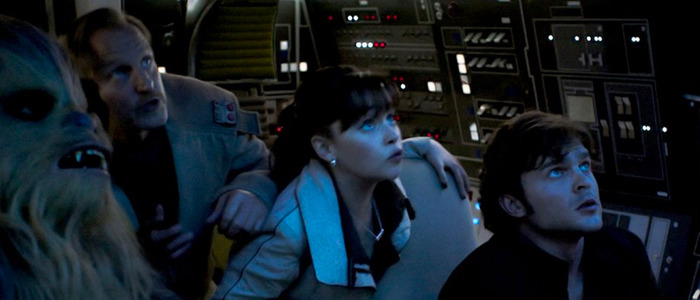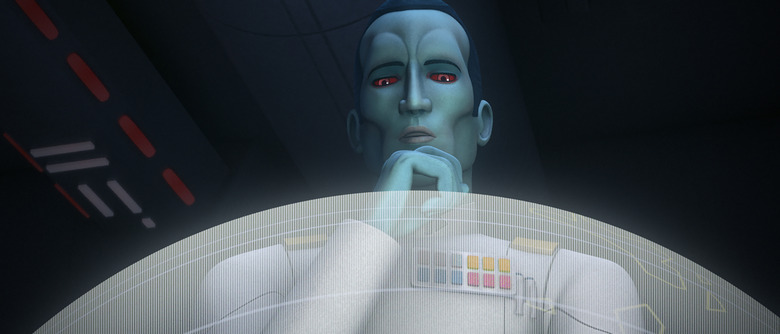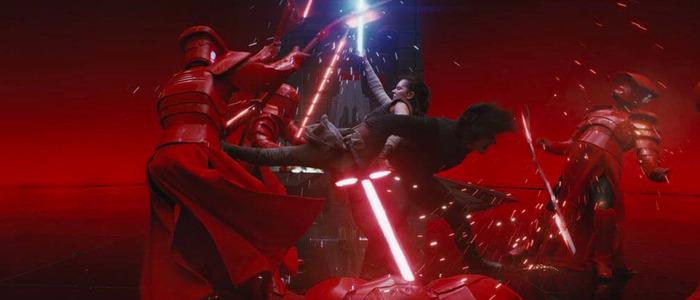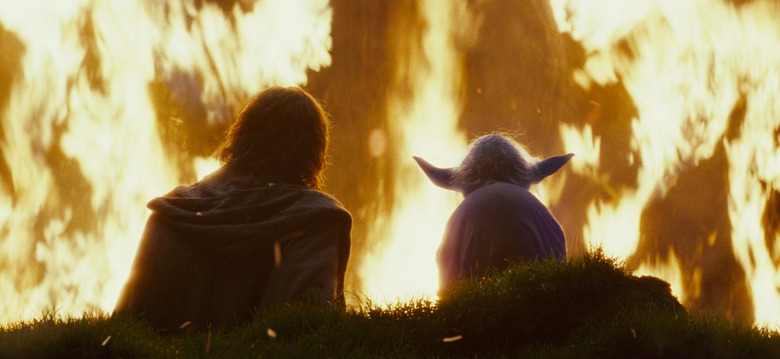How Disney Has Plundered The 'Star Wars' Expanded Universe - And What That Means For The Franchise
Disney's purchase of Lucasfilm Ltd. in 2012 brought with it a number of sweeping changes to the Star Wars franchise as it was known. Obviously, it meant Disney would spearhead a massive onslaught of features, television shows, and other material. But for for particularly committed fans, it meant that a sizeable portion of existing Star Wars content was to be thrown away. The Expanded Universe, as it was dubbed at the time – all the licensed books, comics, video games, and other material that orbited the movies – was to be scrapped, to be replaced by content supervised by the newly-formed Lucasfilm Story Group.The EU suddenly became the "Legends Universe," an alternate version of the events in the Star Wars timeline. Though they were never considered full canon, occupying a lower tier of canon than the Lucas-approved movies and TV shows, now they would be stripped of all legitimacy, effectively taking on the status of commercially-published fan fiction. An entire mostly-consistent chronology and universe, crafted over decades, was obliterated like Alderaan – including quite a few beloved characters and storylines.Only, they also kind of weren't.Though the new, Disney-owned Lucasfilm dropped the EU from canon, it still retained the rights to all the Star Wars material previously published by Lucas Books, LucasArts, and other sister operations. This meant that the Lucasfilm Story Group, and the writers of subsequent films, TV shows, books, and so on, were free to re-use those concepts in their own official canon. Given that the Story Group included people like Pablo Hidalgo who'd been around since the Expanded Universe days, it seemed entirely plausible it might plunder the EU for ideas.And that's just what happened. Post-acquisition, Star Wars constantly references the Expanded Universe – or directly lifts from it. It's a fascinating trend, and one whose intentions and effects are muddy and inconsistent.
Solo: A Throwback Story
Solo: A Star Wars Story is the latest and one of the starkest illustration of this practice. As a prequel, it's inherently backward-looking, and it engages heavily in one of the things EU authors loved most: reverse-engineering every tiny detail from the Star Wars films. Though the spice mines of Kessel were mentioned in the original Star Wars, and the mines as seen onscreen bear little resemblance to the low-oxygen, low-temperature environment seen in the Jedi Academy trilogy, some EU elements managed to creep in.In the books, Kessel is surrounded by a network of black holes known as the Maw, which also contains the facility that designed and built the Death Star. The movie drops the number of singularities to one, but specifically refers to it as The Maw – a clear nod to the EU. The perilous Maelstrom surrounding the planet, too, echoes the novels' Maw, given that navigating it requires a considerable amount of needle-threading. And it might be a stretch, but a tenuous connection could be inferred between the mine-dwelling energy spiders of the novels and the cloud-dwelling energy Kraken of the film.Less significantly, but more pervasively, Solo is strewn with references to old EU material. Lando Calrissian is periodically seen dictating stories, or telling them at sabacc tables, that reference L. Neil Smith's Lando Calrissian Adventures novels. The planet Mimban, on which Han Solo briefly fights for the Empire then frees Chewbacca, comes from the very first Star Wars novel, Splinter of the Mind's Eye. Most amusingly, Qi'ra professes a familiarity with Teras Kasi, a martial art first seen in the Shadows of the Empire novel, which formed the basis of underwhelming PlayStation fighting game Masters of Teras Kasi. I thought everyone hated that game; apparently not.
The Franchise Awakens
Though the films and TV shows produced under Disney's reign have charted their own path in many ways, they also cribbed heavily from the Expanded Universe.The galactic scenario in The Force Awakens comes straight out of the EU, with a few changes. A New Republic rules the galaxy, with Leia heavily involved. Remnants of the Empire become radicalised under various would-be dictators and unstable dark Force-users. Luke Skywalker ran a Jedi Academy in the books, as in the movies. There, too, he trained the offspring of Han and Leia only to have one of their sons (though named after Anakin, not Ben) become a powerful Dark Side user. Sound familiar? Even The Last Jedi, for all the new territory it charted, couldn't resist including an equivalent of the EU's Interdictor-class Star Destroyer (as also seen in Rebels).On TV, the Expanded Universe is even more visible. Most notably, the character of Grand Admiral Thrawn – the blue-skinned, white-uniformed Imperial officer originating in Timothy Zahn's Heir to the Empire book trilogy – was written into Star Wars Rebels as a major villain. But though Thrawn is the most obvious inclusion, he's far from the only one. Fellow Imperial baddies Pellaeon and Rukh make appearances, as does Sith homeworld Malachor. The TIE Defender starfighter from the TIE Fighter video game makes a prominent appearance, and a Mon Calamari engineer is depicted as designing the B-Wing fighter – a nod to Admiral Ackbar doing so in the EU.Even the upcoming Episode IX may plumb the EU well. Early casting information hints that there's a middle-aged character named (for the purposes of casting, at least) Mara – a very notable name indeed. In the old Expanded Universe, Mara Jade was possibly the most beloved character: a smuggler, a former Imperial agent, a Jedi Master, and later wife of Luke Skywalker. Whether or not the Episode IX character is based on Mara Jade, or even ends up named Mara at all, is up in the air – but it wouldn't be out of sync with Lucasfilm practice so far to give her a nod (especially given that Leia won't be appearing in the film).
The Story Group Strike Back
Why did Lucasfilm elect to do this? Why borrow ideas from material the company actively disowned, instead of exclusively inventing new things? There are a few potential reasons. In some cases, it can be chalked up to coincidence: it made sense for Luke to begin training new Jedi, for example, and for a New Republic to form after the fall of the Empire. Likewise, with Solo taking the action to the spice mines of Kessel (mentioned in A New Hope, and retconned slightly into hyperdrive fuel mines), it made sense to check up on how that region had been portrayed earlier.Alternatively, the EU can be seen as a unique resource for Lucasfilm writers: after the Disney purchase, they're not bound by any of its chronology or rules, but since the material is owned by Lucasfilm, they can pluck items from it at will to use in their own stories. A goodly portion of the EU is pretty risible, but there are a few ideas in there that someone in the Lucasfilm Story Group clearly likes. Characters like Thrawn are too delicious and iconic to pass up.The final possible reason, of course, is to throw a bone to die-hard Star Wars fans. There was significant outcry upon the Disney deal going down over the de-canonisation of the EU, and fans have vocally relished what cameos have appeared in material released since then. For fans, these shout-outs are treats, made all the more meaningful when one has spent years obsessively following licensed Star Wars stories (as I once did). And for non-fans, the likes of Thrawn or the Maw might as well be entirely new inventions.The phenomenon is much like the Marvel Cinematic Universe's background Easter eggs: things for fans to pick out with glee, and for regular audiences to either gloss over or look up later. On one hand, that's a pretty safe way to do incredibly deep-cut fan service. On another, it runs the risk of alienating fans in the same way Marvel's post-credit teases mystify casual audiences. And on another, third hand, it can be seen as a subtle hook to bring new audiences to the freshly-redubbed Legends universe.
Return of the Canon
Lucasfilm's cherry-picking approach to the Expanded Universe creates intriguing issues with regards to canon. As a rule, material not featured in the Star Wars movies, TV shows, or Disney-produced books or games is not canon – a clear, unambiguous dividing line. But that line has become blurred somewhat of late.Glancing references like those found in Solo, especially, create potentially maddening conundrums. Though they cement certain places, characters, and events as canon, they don't do the same for the stories the EU's creators told around them. Thrawn, for example, is now a canon character based on a character from a licensed novel that now holds only slightly more canonical weight as fan fiction. 2012's sweeping abandonment of the Expanded Universe now feels inconsistent and hypocritical.The other issue, of course, is one of originality. Part of what made The Last Jedi so enthralling and exciting was its willful moves in new directions, pushing the fantastical Star Wars universe to places (physical, emotional, and philosophical) it had never been before. Indeed, Disney's decision to scrap the Expanded Universe was made solely so that it could make new sequels, tell its own stories, and not have to worry about canon disputes. That's the way it should be, in this instance. But the EU's slow creep back into relevancy keeps the franchise's gaze focused backwards, at existing content. Given that Disney's non-saga output has leaned on similarly backward-looking projects like Rogue One and Solo, that's a disappointing pattern to establish.I won't lie; I got a kick out of the Maw (sort of) appearing in Solo. But that momentary grin of recognition was short-lived. The Maw wasn't anything new; I didn't start imagining new stories around it, because I'd already read them. If Lucasfilm really wants to expand its universe, it needs to jettison the Expanded Universe – for good, this time. Otherwise, it's telling a story of a galaxy just over there in my bookshelf, a galaxy that's been gathering dust since a long time ago.




